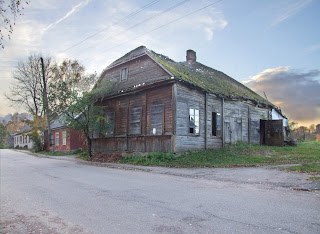 Latvia: Wooden synagogue in Subate faces collapse
Latvia: Wooden synagogue in Subate faces collapse by Samuel D. Gruber
photo: Sergey Kravtsov/Center for Jewish Art
(ISJM) Architectural historian Sergey Kravtsov of the Center for Jewish Art (Jerusalem) reports that an abandoned wooden synagogue in Subate, Latvia documented a month ago is in serious danger of collapse. The wooden synagogue in Subate was built in 1880 as a Chabad synagogue, and somehow survived the Second World War, when so many other wooden synagogues in the region were burned. After the war, the building was used as a garage, and it was later
abandoned. Now its roof is in terrible condition, and according to Kravtsov, it is not likely to survive a heavy snowfall. Still, it has managed to survive this far, and the walls appear to be fairly strong.
The documentation at Subate is part of a survey of the synagogues of Latvia begun last fall by the Center in partnership with the Mr. Meijer Melers and the Jewish Museum of Riga. According to Melers and Kravtsov, Latvia once had 280 synagogues (Old photos and information about many of these are illustrated in the large volume, Latvia Synagogues and Rabbis 1918-1940, edited by Rabbi Menachim Barkin and published by the Jewish Community of Latvia in 2005). Today, 43 synagogue buildings are known to exist. Most are masonry buildings, the rest are made of wood.
In discussing the situation at Subate with ISJM, Kravtsov and Melers both addressed the financial and logistical difficulties involved in saving the synagogue; it in unlikely to gain support given its out-of-the-way location and lack of local sponsor. However, there is the tradition and possibility the building could be moved to an outdoor architectural museum (scansan) where it would be protected and widely viewed. This is a solution that has been carried out for several 19th century wood-frame synagogues in the United States. Other synagogues from around the world have been moved, at least in part, and re-assembled with varying degrees of success in Israel. For now, funds are needed to carry out “first-aid” in situ repairs to rotten sections, and to evaluate the overall building condition to see if moving and re-erection is even possible. One challenge to including the synagogue at the scansan would be the need to reconstruct to some degree the interior arrangement – all of which is now lost.
Subate (Yiddish: Shubitz or Subitz) was a modest Jewish center near the Lithuanian border. For history and photos of the Jewish cemetery and mass grave sites see:
http://www.jewishgen.org/latvia/subate.html
See Sergey Kravtsov, “Survey of Synagogues in Latvia,” in bet-tfila.org/info Nr. 6 on-line at http://www.bet-tfila.org/data/info-pr-0207.pdf., pp. 6-7.




No comments:
Post a Comment